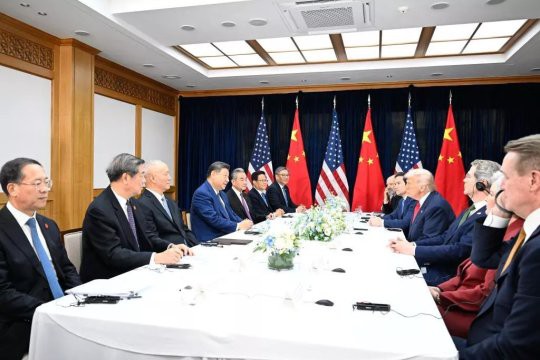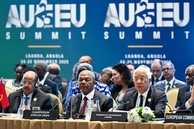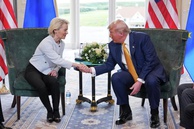Chinese President Xi Jinping and his US counterpart Donald Trump recently met in South Korea’s Busan. The leaders of the world's two largest economies sat down for negotiations at a critical juncture for US-China relations when Washington and Beijing are in a state of a full-blown trade war. The meeting, which, just a few days earlier, was in doubt, lasted 1 hour and 40 minutes. Commenting on its outcome to reporters, Donald Trump described it as “amazing," called Xi Jinping "a great leader" and said that the result of the talks was a “12 on a scale of 1 to 10.” Xi Jinping stated that countries should focus on "the long-term benefits of cooperation." Few details of any actual agreements were released and the general outcome of the Busan parley looks just like a positive framework agreement.
A promise to implement a broad package of economic restrictive measures against China was part of Donald Trump's election campaign as early as 2016. The contours of a "trade war" between the two countries began to emerge in the summer of 2017, and in January 2018, the White House imposed four-year tariffs of at least 30 percent on imports of solar panels and washing machines from China. The confrontation kept heating up until the end of Trump's first term, and continued under President Joe Biden, with the US and China alternately imposing, lowering, and sometimes even canceling tariffs and other restrictive measures against each other, becoming ever more deeply entangled in trade and economic "battles" of global and local significance.
Upon his return to the White house, Trump immediately went on the offensive, imposing the first tariffs in February 2025, and raising them to 20 percent by early March, amid claims that Beijing was not working hard enough to curb illegal fentanyl shipments to Latin America. Essentially, fentanyl is a painkiller used to relieve pain during surgeries or in other serious conditions, but it is also used by drug cartels to create narcotics that have killed many people in the United States.
In a move announced in grand style in early April, Trump introduced massive tariffs against most countries worldwide. The White House openly declared a tariff war on China and demanded its capitulation ramping up import duties on Chinese goods to a prohibitive 145 percent.
Beijing – almost the only one among America's trading partners – pushed back with equally tough retaliatory measures against the US, which apparently proved to be extremely painful. By mid-May, Trump's representatives had already agreed with the Chinese on the terms of a 90-day trade truce. By June 10, the sides had agreed to abolish all prohibitive duties imposed against each other by that time. However, by early autumn, a new escalation happened with the past 45 days having seen Washington and Beijing only raising the stakes in their trade war. China tightened export controls on rare earth minerals, essential for the US military-industrial complex, on clean energy, and the technology sector. The US responded by imposing export controls on technologies, including semiconductors and microchips used in artificial intelligence.
Both sides are suffering losses. According to China's foreign trade statistics for September, trade between the two countries dipped by more than a quarter compared to last year. However, signs are that some Chinese goods destined for the US market still get there via third countries. Meanwhile, Trump’s tariffs on Chinese agricultural products prompted Beijing, previously the largest buyer of US soybeans, to look for other suppliers, thus dealing a crushing blow to American farmers.
Shortly before embarking on his Asian tour, Trump, who portrays himself as a skilled negotiator capable of striking deals in direct dialogue with other leaders, told journalists that he was optimistic about his ability to clinch a trade deal with his Chinese counterpart to insure the resumption of rare earth metal exports to the US, secure additional commitments to limit fentanyl, and open the Chinese market for greater imports of US soybeans.
In the run-up to his meeting with Xi, Trump tried to bolster his position by announcing a series of "breakthrough" trade agreements signed during his Asian tour with Malaysia, Japan, and South Korea. In late October, US Treasury Secretary Scott Bessant stated that the United States could raise the stakes by preparing a series of new export control measures on technology if China failed to demonstrate willingness to change its position on rare earth metals, which "hamstrings" US technological and military industries.
As for Xi Jinping, he deemed it important to emphasize that the meeting with Trump did not outweigh Beijing's other priorities. This primarily refers to extensive agreements with the Asia-Pacific Economic Cooperation (APEC) countries. Thus, the Chinese leadership demonstrates its ability to effectively manage the international agenda and strengthen the country’s position on the global stage. As for the trade war with the US, Britain’s respectable magazine The Economist believes that China is winning it. Beijing has learned to manage trade escalation and take retaliatory measures as effectively as America. Moreover, it is successfully experimenting with its own extraterritorial trade rules, thereby shifting the vector of the global economy. The Economist cites the following three reasons.
Firstly, Beijing has proven its ability to resist Washington’s coercion and skillfully retaliate, thus achieving what is called "escalation dominance." For example, tariffs that Trump imposed against China in April were canceled following a Wall Street crash. Recently, after China introduced restrictions on the export of rare earth metals used in high-tech manufacturing, Trump threatened 100 percent tariffs only to back down again. His threats to paralyze China with a near-complete embargo hold no water either as this would also harm the US. This year, the Chinese stock market has grown by 34 percent in dollar terms – twice as much as the S&P 500 index.
Secondly, China is setting the tone in shaping new global trade rules. On the ruins of the old liberal trade order, Beijing wants to build a system that will rival the American empire. Beijing has already altered its trade geography and is successfully using US experience in regulating global markets in its own interest through licensing, because it is the world's leading manufacturing power and the largest trading partner for over 70 countries.
Thirdly, the trade war with America has only strengthened the positions of Xi Jinping and the Communist Party within China.
Following bilateral meetings between high-ranking US and Chinese representatives and with officials from third countries that preceded the Xi-Trump parley, many concluded that Beijing achieved more and secured more favorable agreements, while Washington's efforts to expand ties with allies and partners continued to falter.
At the same time, prospects for a comprehensive and definitive trade agreement have not yet materialized, with both sides demonstrating their fortes and erecting barriers using various instruments of pressure. i
What are the first results of the negotiations in Busan? Trump and Xi Jinping agreed on a one-year trade truce, during which tariffs will be lowered and export controls eased, promising temporary relief for businesses and consumers. According to Western media reports, starting next year, a series of high-level meetings will take place, including a visit by Trump to China and Xi to the US next year. In addition to removing the threat of 100 percent tariffs mentioned earlier this month, Washington will reduce tariffs on Chinese exports from 57 to 47 percent, while China agreed to suspend – also for one year - its most recent ii export control measures for rare earth metals.
Furthermore, according to Trump, as part of the agreement, the US will defer charging fees on Chinese ships arriving at American ports, and China agreed to purchase "large quantities" of American soybeans and intensify efforts to curb shipments of fentanyl precursors. President Trump also hinted that Beijing might soon finalize a deal to purchase American oil and gas extracted in Alaska. China's Ministry of Commerce stated that the US would suspend plans for export controls on Chinese companies' subsidiaries. Additionally, according to various sources, China agreed to buy more than 12 million tons of soybeans from the US this year.
Trump said that the agreements would be finalized "quite soon" and that negotiations on the deal would proceed within a year. Judging by official statements made so far, other sticking points in bilateral relations had been discussed very briefly, if not skipped at all. The parties agreed to continue work on the issue of TikTok's sale. The Taiwan issue, according to Trump, was not discussed, while the conflict in Ukraine was discussed "very actively." However, Xi was more reserved and, as far as can be judged, made it clear that he did not intend to stop buying Russian oil, signaling his desire to maintain a strategic partnership with Moscow.
Summing up the talks in Busan, Xi Jinping emphasized the leading role of trade and economic ties for China-US relations and said that they should not become a stumbling block. He urged Washington to continue engagement at various levels to improve mutual understanding. The world’s two largest economies can work together to create new opportunities for all. With China set to play host to next year’s APEC summit and the US to host the G20 meeting, mutual support for each other's efforts would contribute to achieving positive outcomes of these crucially important international events. China and the US should also effectively engage on international issues, both globally and regionally. iii
According to optimists, the X-Trump summit in South Korea signified a more comprehensive truce than what the two countries had achieved in recent months. According to realists, any agreements reached during that meeting will be temporary and limited in nature as contradictions between the two countries could resurface already early next year, during reparations for Trump's visit to China.
Experts believe the trade war between the US and China is not yet over as the parties keep balancing on the brink of escalation, where tariffs and retaliatory duties have become standard practice. Both economies are under pressure: a decline in industrial production and inflation uncertainty in the US, and concerns about growth rates and consumer spending in China. As a result - negative implications for the global economy as well.
Neither side can afford a radical escalation today. That is why Washington and Beijing needed a "pause." The summit in Busan was designed not so much to sign a "grand deal" as to achieve a kind of "ceasefire" – a trade truce that would allow them to catch their breath and buy time. And this goal has been achieved.
The views of the author are his own and may differ from the position of the Editorial Board.
-----------------------------------------------------------------
[i] https://www.bloomberg.com/news/articles/2025-10-23/trump-seeks-elusive-trade-deal-with-xi-in-high-stakes-meeting
[ii] Announced on October 9. US observers point out that the Chinese Ministry of Commerce's statement on the Xi-Trump agreement does not address other critical mineral export controls that Beijing imposed before October, including restrictions on gallium and germanium, which are essential for semiconductor production. China also continues to require companies to obtain licenses to export certain rare earth metals and magnets.
[iii] https://t.me/shuohuaxia/19570
read more in our Telegram-channel https://t.me/The_International_Affairs

 2:21 03.11.2025 •
2:21 03.11.2025 •



























